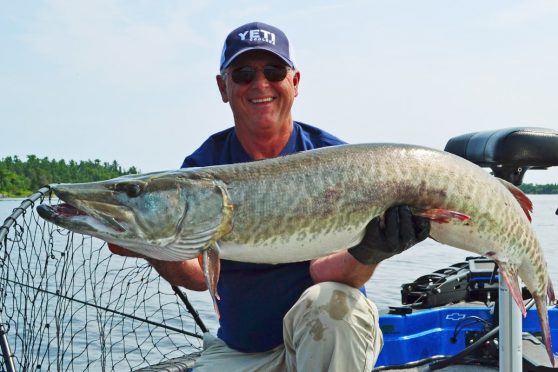Can a Muskie Pull you Overboard?
SHARE THIS POST
It was nearly 3 p.m. when we pulled up near a small rock-studded island that was not much different than the hundreds of similar ones scattered all over the incredible body of water we were on. Arguably, this spot was not nearly as impressive structurally as many of the other spots we’d fished, but it was on our scheduled milk run of targets.
I’ve always surmised spots like this do offer one distinct advantage over many others: if a muskie’s present you’ll definitely get a cast to it in short order. These can also be hit quickly and efficiently, as it’s the larger complex structures that eat up precious time. Smaller targets are superior since you get a cast over a hot fish within minutes.
The best lures and top technique of the trip seemed to be smaller inline spinners run at very high speeds; larger spinners were only drawing follows. Muskies were definitely responding most aggressively to lures in the 5- to 7-inch range worked in a very quick fashion. With that in mind, I was sorting through a wide selection of 700 Buchertails on this trip—switching out between full tinsel/Flashabou versions and a bucktail/tinsel combo with equally good results. The best producer for me on this trip overall seemed to be a gold/red pattern with a copper blade that I nicknamed “Goldilocks” a few years back.
Briefly touching the “on” button on the trolling motor with my right toe and pushing down slightly on the foot pedal to turn the bow to the right, I launched my third cast toward the island, placing my spinner inches from jagged rocks just inches below the water’s surface. Synchronizing my reel engagement with the lure’s splash followed with a vigorous retrieve and propelled the lure forward with a strong pulse. The flashy copper blade was rotating intensely, creating a bulge on the flat water. I backed off on the retrieve just a tad once I was certain the lure was free of the ultra-shallow rocks.
About midway through the retrieve I felt the urge to “gun” the reel a few quick turns again. This has worked well for me in past as a strike trigger from following muskies at the mid-range level in my retrieve. However, it didn’t work this instance. But what it did do was stimulate a big muskie that was following deep and out of sight initially. My partner and I seemed to spot the thick-bodied lunker at the same time. Instinctively, I sped the lure up as it neared the boat, which seemed to excite this fish even more. In fact, you could say it “electrified” it.
Instead of closing in on the lure from behind, the big fish suddenly flicked its tail and scurried up alongside the spinner in an eerie, predatory and challenging posture. At nearly the same time I was nearing the end of the retrieve and was about to execute a figure-eight maneuver, this brute abruptly turned, opened its gaping jaws and engulfed the entire bait. But instead of hovering in place after the strike like many muskies do, this fish promptly turned 180 degrees and exploded outward with speed and power I’ve never before witnessed in over 40 years of muskie fishing.
Since I was using an extra-long 8-foot 6-inch medium-heavy power rod, stout 80-pound-test braided line and a quality reel with a good drag, everything still should have been good, but unfortunately, it wasn’t. First off, the drag was set too tight, and second, I later realized I had spooled my reel improperly. Without warning, I was literally jerked off my feet and onto the floor of the boat. Frankly, it is a good thing that this muskie took off in a direction toward the bow since I ended up crashing into the front control panel along with the sonar unit and the trolling motor stem. Honestly, if that fish would have headed straight away from the point of impact, I’m certain I would’ve gone overboard.
Never before have I been literally ripped off my feet by the strike of a muskie, but now here I was on my knees with my arm extended trying desperately to hold onto the rod while this wild, powerful fish pulled for all it was worth. The stress on the tackle was far more than I’ve ever thought possible. After a few minutes I managed to get some of my act together, but still could not get back up on my feet to land it. Admittedly, this fish kicked my butt. I felt as if I had been hit by a Mike Tyson left hook.
I was also amazed that the rod, line, leader and lure had held up. And it was about this time that I noticed that two of the three hooks on the lure’s treble (hook) were broken off. Desperate for help at this point, I summoned for my partner to grab the net and land this lunker for me. I was definitely in no shape or position to land it by myself.
As the net enveloped this fish, it once again exploded in a fury. It was almost as if this muskie was now going to duke it out with the landing net as well.
Are you enjoying this post?
You can be among the first to get the latest info on where to go, what to use and how to use it!
Finally, it relented, and the fight was over.
Eventually, I got back off the boat floor and was able to get the fish unhooked, photographed and released. As I contemplated this experience while wrapping up my TV segment, I couldn’t think of a more incredible muskie encounter in all my years of guiding or on television. I was both mentally and physically spent.
Summarily, several valuable lessons stuck out from this encounter that I wanted to pass along to you:
1. Do NOT lock the reel’s drag completely down. While some anglers have suggested this is a proper drag setting and promotes the best possible hook-set, I would never think of doing this after what I encountered. The drag has to be set so it still gives line under extreme stress.
2. Set the drag from the end of the rod tip, and not from the reel. Have your partner grab your line at the end of the rod tip and pull it out like a fighting fish. Set the drag so line will slip evenly, but only under extreme pull.
3. Always begin spooling your reel with a lighter-gauged mono for backing. I made the mistake of spooling up with 80-pound-test braid complete from the bare spool to the full load. Spooled in this manner, braided line has a tendency to dig into itself under a tight setting. This renders the entire drag system useless. Instead, spool up with a lighter-gauged 15- to 20-pound-test mono as backing and attach your main braided line to it with a good knot. The braid (line) will then spool more evenly and most of this digging tendency will be eliminated. In fact, you can then set your drag very tight to a near complete “lockdown” setting and it will still function correctly. The amount of actual braided line needed on any casting situation is about 75 yards. You are better off re-spooling with a fresh 75 yards every week or so than loading a big baitcaster from bottom to top with 100 yards or more—the inside line is virtually wasted and it creates drag-setting issues.
It took over four decades for a muskie to finally knock me off my feet, but it truly did happen. Perhaps it is a sign that I am aging, but honestly, be leery of a drag that is set too tight. Trust me—I now know firsthand.
For more information…To see video of this event on Bucher’s YouTube channel, go to: youtube.com/watch?v=jVEBxc4YNd0.
MWO
SHARE THIS POST
Did you enjoy this post?
You can be among the first to get the latest info on where to go, what to use and how to use it!
Joe Bucher
Joe Bucher is a Freshwater Fishing Hall of Fame Legendary Angler, book author, lure designer and host of Fishing with Joe Bucher TV series.



